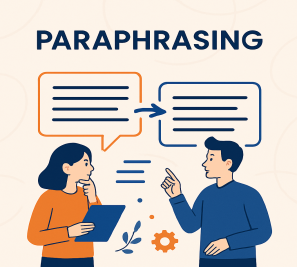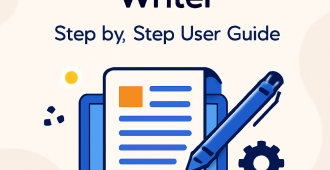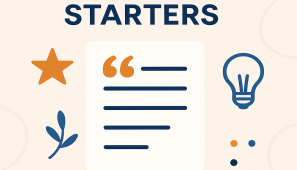The most important thing in writing, be it an academic essay, blog, or research paper, is to sound like yourself. Paraphrasing, or rewriting information in your own words, is an essential skill in a writer’s toolbox that helps them transform dense text into plain language, adjust the tone, or build on another person’s work.
But how to paraphrase without plagiarism?
Knowing how to paraphrase without plagiarizing a thing is an exceptional skill that helps you craft unique blog posts, research papers, marketing copy, social media posts, and more. In this blog post, we will briefly discuss the steps on how to paragraph without plagiarism, some excellent paraphrasing tools, and practical examples to help you understand better.
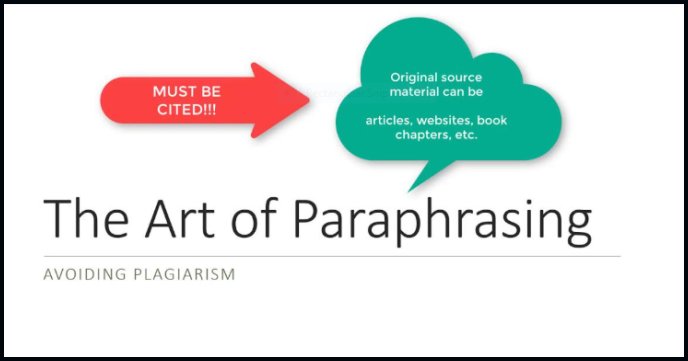
What Is Paraphrasing?
Paraphrasing refers to the process of rewording or restating someone else’s piece of writing or ideas into your own new words while keeping the original meaning intact. Unlike summarizing, paraphrasing involves understanding the source material and including the same amount of details as the original in the final copy. In paraphrasing, writers have to demonstrate comprehension or make the text more understandable and readable.
Mixing words in paraphrasing alongside the original quotes works well and helps your paper flow look more natural. The skill is also used to create and polish social media posts, marketing copies, and business writing contexts to convey the intact information to various audiences.
What Is the Purpose of Paraphrasing?
The purpose of paraphrasing is to provide:
- Clarification: Paraphrasing involves simplifying complex language or text into easy-to-understand content for clarification.
- Simplification: Breaking down lengthy or complex sentences into more concise and clearer text.
- Adaptation: Adjusting the style, tone, and level of formality of the original text according to the audience’s taste.
- Avoid Plagiarism: Citing the comprehension of the source without copying word-for-word.
- Boost Engagement: Presenting the original information in a more user-friendly and compelling way for readers.
Effective paraphrasing preserves the essence of the original content by making it more accessible or suitable for a new purpose. It is a great skill in academic writing, blog writing, professional communication, and content creation.
Paraphrasing Vs. Plagiarism: What Are the Key Differences?
As stated, legitimate paraphrasing is the process of rewriting or restating someone else’s ideas in your own words by keeping the original meaning intact. In paraphrasing, we use different vocabulary and phrasing to change the sentence flow and organization of the original text. The new content is always credited with an in-text citation and reference. It is used to clarify, simplify, or adapt content for a new audience.
Plagiarism, on the other hand, is passing off someone else’s content as your own. Some people think that changing a few words will be enough to avoid plagiarism, but that’s not true. Plagiarism is just making superficial changes that involve just swapping synonyms. The sentence structure looks very similar to the source. It misrepresents authorship, whether intentionally or accidentally. Moreover, in plagiarism, no citation is given to the source.
Side-by-Side Practical Examples
Let’s say you want to paraphrase the content below about climate change and its effects.
“Climate change is causing more frequent and intense heatwaves, which threaten public health, agriculture, and natural ecosystems. Without significant reductions in greenhouse gas emissions, these extreme weather events will become even more severe.”
- A Good Paraphrase (Properly Rewritten & Cited): According to NASA 2022, global warming is causing more frequent and dangerous heatwaves, endangering human health, food production, and wildlife. If carbon emission is not controlled, the conditions can become even worse.
- A Bad Paraphrase (Too Close to the Original): Climate change is leading to more frequent and intense heatwaves, which affect public health, agriculture, and natural ecosystem. Without proper cut in carbon emission, these extreme weather conditions will even become more severe.
- Direct Plagiarism (Copy-Pasted Content): Climate change is causing more frequent and intense heatwaves, which threaten public health, agriculture, and natural ecosystems. Without significant reductions in greenhouse gas emissions, these extreme weather events will become even more severe.
Therefore, while paraphrasing, make sure you change the wording, sentence structure, and always cite the source to avoid plagiarism.
How to Paraphrase Without Plagiarizing? A Step-by-Step Guide
Paraphrasing is an art that lets you create unique content without changing the context. To paraphrase the content thoroughly, follow the easy-to-follow steps below:
Read the Original Text Thoroughly
To rewrite a paragraph or an article, read it carefully and thoroughly to understand the source material. Select the piece of the article you want to restate. Pick points that support your topic.
Note Down Important Points
The second is to write down the important points in the original content that are worth using in your research paper, blog post, or market copy. Make the list of these points for your convenience.
Try Rewriting the Selected Content by Your Own
When you try rewriting the selected piece of content, you can leverage your creative skills to state the same message differently. After rewriting, you can confirm that all your information is correct by matching it with your notes.
Change the Language and Structure of the Sentence
Changing the sentence structure and language is another effective rule for paraphrasing. For this, you can use synonyms to replace the essential words in the original passage. For example, in paraphrasing a scientific passage, you can use the word elderly for researchers or seniors.
Similarly, you can rearrange the order of certain phrases and clauses or combine or break apart the original sentence to change its structure. Changing the parts of speech, such as converting a Gerund into an Operative verb, can also help. However, don’t overuse the passive voice.
Review the Original Source
Once you make a rough draft, review the actual source of the content to make sure your rewording is different enough. Avoid patch writing to prevent any confusion for readers.
You can also check the originality of your rewritten content by passing it through plagiarism-detection tools like Oreate AI.
Proofread Your Content to Ensure Accuracy
Proofreading your rewritten content is a good strategy to ensure you haven’t changed the original context of the text while adjusting its style and structure. You can also get help from tools like Oreate AI or Grammarly to proofread your content for clarity and grammatical correctness.
Always Add Citations
In the end, to make your content credible, don’t forget to add citations to it. Also, make sure you use the correct citation style or format. For example, you can use either APA, MLA, or Chicago. Similarly, for paraphrasing articles, you can use a parenthetical citation.
That’s all from the portion on how to paraphrase without plagiarizing.
When Should You Paraphrase?
Paraphrasing is useful in many situations. You want to paraphrase when the wording of the original sentence is less important. Paraphrasing or rewriting is important to maintain continuity of style in your article or paper.
You may use the paraphrasing option when you want to:
- Change the Arrangement of Ideas: You may want to change the arrangement of the sentences or your ideas to pick the points that are most related to your topic.
- Simplify the Context: Sometimes, you want to simplify the complex arguments, vocabulary, and sentence structure.
- Clarify the Material: In some cases, you want to clarify technical passages or specialized information in a user-friendly language.
- Avoid Overusing Quotations: Sometimes, you want to avoid direct quotes to make a smoother and more cohesive narrative.
- Report Numerical Data or Statistics: Similarly, paraphrasing is also useful when you want to report numerical data or statistics in your preferred style.
Best Paraphrasing Tools You Can Try
Manual paraphrasing is good, but it consumes time and requires strong vocabulary with excellent writing skills. To save you time and effort, several advanced AI paraphrasing tools can paraphrase an article, a passage, and an essay in seconds. Below are some of the best AI paraphrasing tools that you must try.
Oreate AI: The Best AI Tool for Paraphrasing and Humanizing
Looking for the best AI tool for paraphrasing, long-form rewriting? Get started with Oreate AI paraphraser, the best AI tool designed for text rewriting and plagiarism checking.
The tool offers 9 paraphrasing styles, allowing you to rewrite up to 10,000 words at once. You can refine and edit the paraphrased content, ensuring high-quality, natural-sounding text. Plus, it helps you bypass AI detectors for original, top-quality writing.
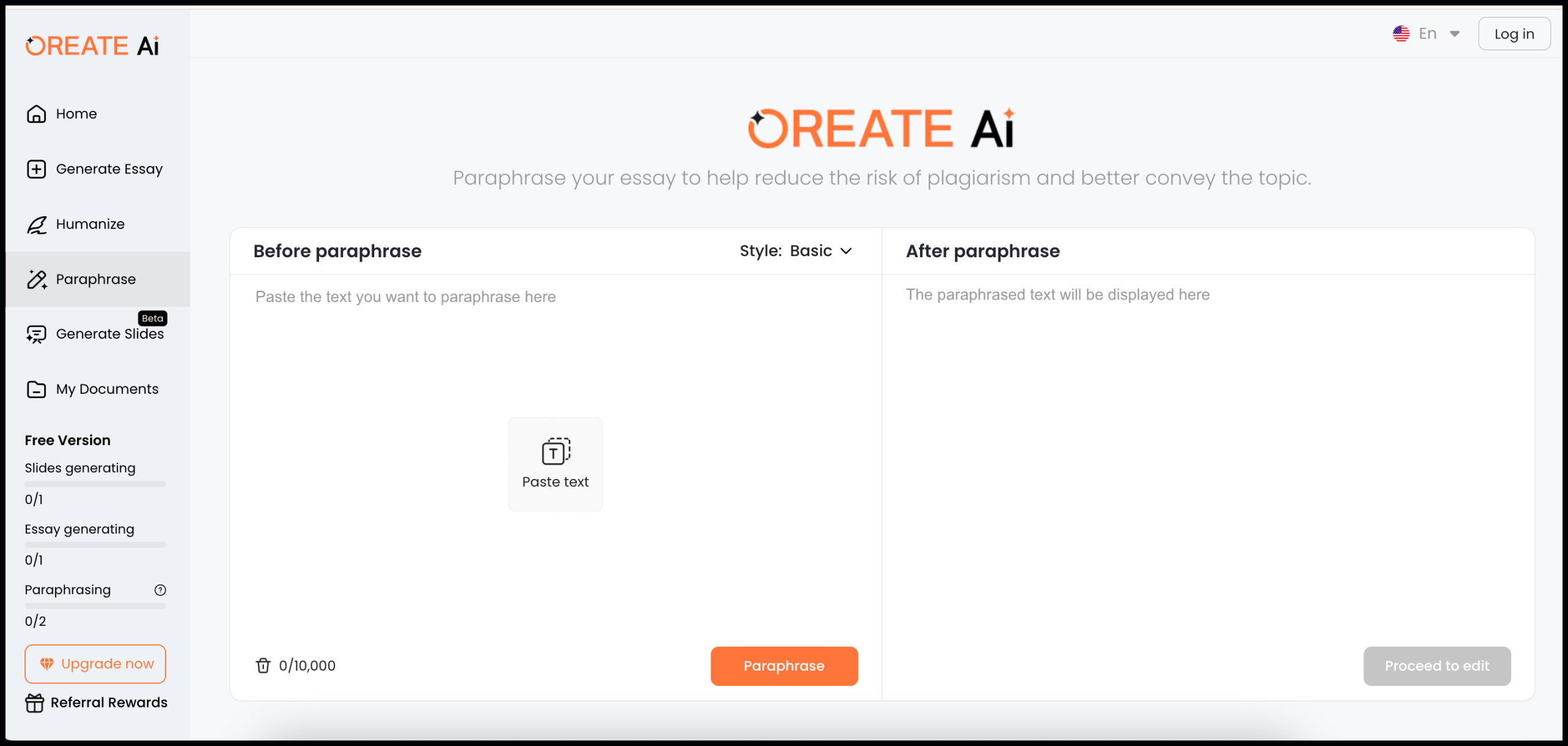
Key Features:
- Advanced paraphrasing with 9 customizable styles
- Paraphrase up to 10,000 words at once
- Humanizes AI-generated text for a natural, engaging tone
- Bypasses AI detectors for high-quality, original content
- Perfect for essay writing
- Easy-to-use
- Intuitive interface
Limitations:
- Currently supports only English, Spanish, and Arabic
QuillBot
QuillBot is one of the most reliable and widely used paraphrasing tools. With its wide range of paraphrasing modes, it is a solid choice for students, content creators, and essay writers.
QuillBot offers extensions for Chrome, Windows, Word, and other browsers like Safari. Along with paraphrasing capabilities, it can also check your content for plagiarism, AI, and grammatical errors. It can add citations from sources and humanize the AI-generated content.
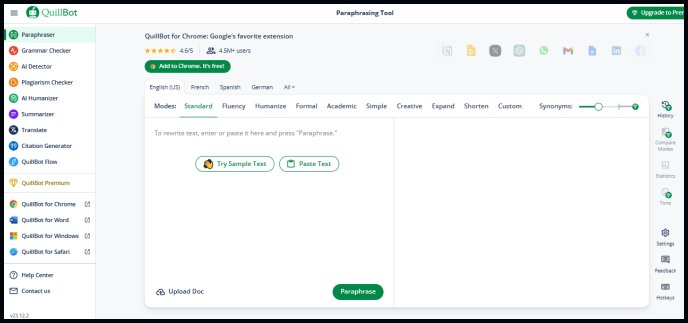
Key Features:
- Extensions for different platforms
- Multi-lingual support
- Best for formal, academic, and simple writing
- Ideal choice to write an academic paper, a blog post, or a social media update
- Easy-to-use interface
- Multiple paraphrasing modes
Limitations:
- Paraphrases only 125 words in the free version
- No plagiarism checker in the free version
- Repetitive phrasing in longer text
- No automatic citation help
- Limited customization in the free version
Grammarly
Grammarly is a full-fledged writing assistant that offers top-notch grammar checking, tone detection, and style suggestions. The tool provides real-time feedback when you write by catching mistakes and offering alternative phrases. It keeps you on track by helping you create polished and professional-looking content.
However, its free version lacks the advanced features and has several limitations. For example, you can paraphrase up to only 600 words in a single attempt. Moreover, plagiarism detection and vocabulary enhancements are not available in the free version.
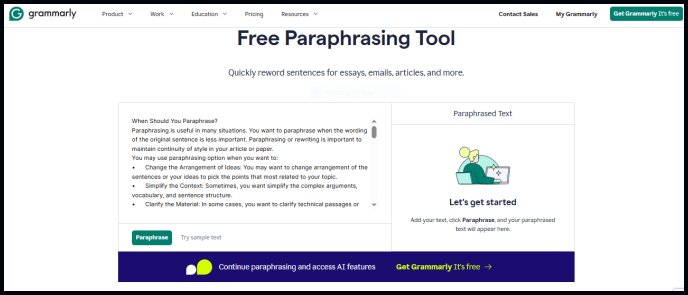
Key Features:
- Seamless integration with 500,000 apps, websites, and programs
- Best for students, researchers, professionals, marketers, authors, journalists, copywriters, and teachers
- One-click paraphrasing
- Best for essays, emails, articles, and more!
- Intuitive and easy-to-use interface
Limitations:
- No offline access
- Limited features in the free version
- No plagiarism and vocabulary enhancements in the free version
Paraphraser.io
Paraphraser.io, another excellent paraphrasing tool, can get the job done without a lot of extra bells and whistles. It is an ideal choice for users looking for a quick and easy way to rephrase snippets of text.
The tool is easy to use, where you can paste the selected content and hit the “Paraphrase” button to get the new version of your content. It has a clean and uncluttered interface that lets you focus on the task at hand.

Key Features:
- Numerous features, including rewriting, essay writing, plagiarism fixing, and rewording articles
- Human-level paraphrasing
- Stat-of-the-art AI Paraphraser
- Maintains the original meaning of the content
- Plagiarism-free output
- Best for colleges and universities
Limitations:
- No offline access
- Paraphrases up to only 400 words in the free version in a single attempt
- Takes time to paraphrase
- Limited advanced features
Paraphrasing FAQs
How can I paraphrase a passage more effectively?
To paraphrase a passage more effectively, you should:
- Reformulate the sentences
- Collect information from multiple sentences and combine themin a single sentence.
- Leave out irrelevant information
- Change the sentence structure by using synonyms of the particular words
- Use AI paraphrasing tool like Oreate AI
Do I have to rewrite every single word when paraphrasing?
No!
You don’t need to rewrite every word. Focus on changing key phrases and sentence structures while keeping the meaning intact. For easy and accurate paraphrasing, try Oreate AI paraphraser. It offers multiple styles, handles up to 10,000 words, and ensures your content sounds natural and original.
Is paraphrasing similar to summarizing?
No, paraphrasing and summarizing are different from each other.
Paraphrasing is explaining someone else’s ideas in your own words. Summarizing, on the other hand, shortens longer sentences by highlighting only key points.
Conclusion
Paraphrasing is an important skill in a writer’s toolbox that lets you write someone else’s ideas in your own words by keeping the meanings intact. The skill can greatly help you refine your essays, articles, blog posts, and social media updates.
To paraphrase a passage uniquely, read it thoroughly, note down its key points, rewrite it by yourself, change its language and sentence structure, and cite the source to make it look credible.
Along with manual paraphrasing, you can also try the AI paraphrasing tools mentioned above. Among them, Oreate AI is a reliable tool that you can use to write unique essays, research proposals, and class journals quickly!
